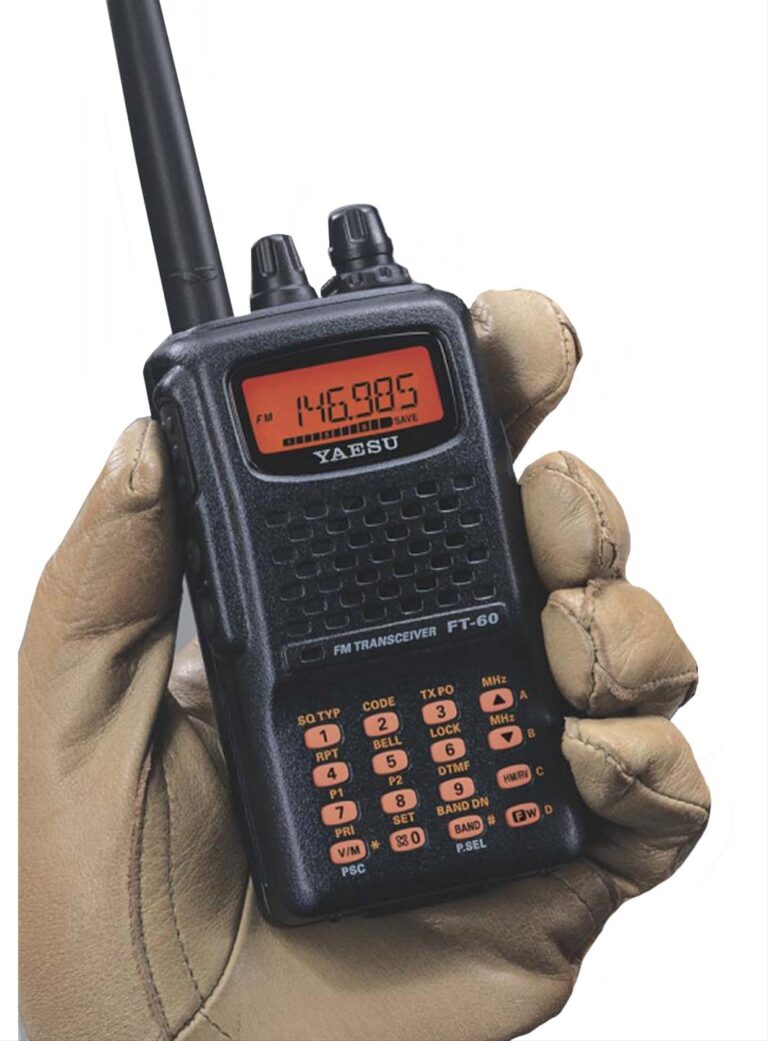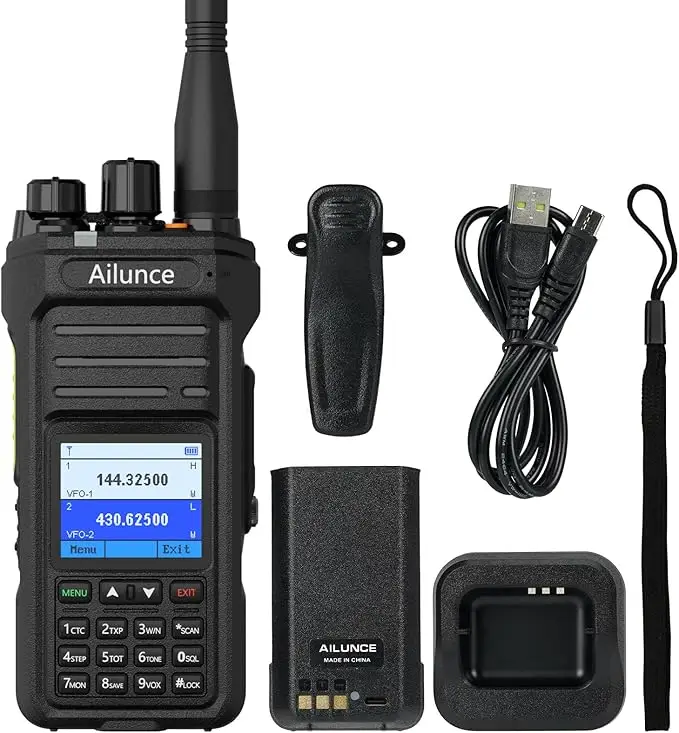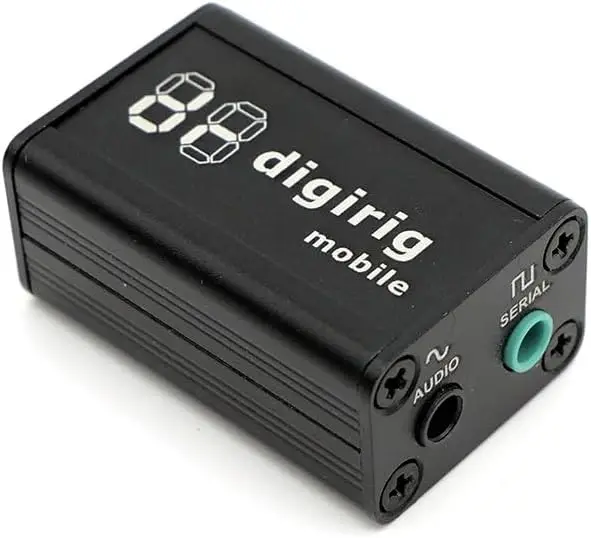In an era where ham radio handhelds compete on color screens, digital modes, and Bluetooth connectivity, the Yaesu FT-60R stands as an curious anachronism. First introduced in 2004, this analog-only dual-bander has somehow remained in continuous production for two decades – a lifetime in consumer electronics. After revisiting this radio in 2025, I’ve come to understand why it refuses to fade into obsolescence, and why so many operators still swear by it as their primary or backup handheld.
Affiliate Disclosure:
“Just so you know, some of the links on this page are affiliate links. This means if you decide to make a purchase through one of those links, I might earn a small commission at no extra cost to you. Your support helps keep this content going—thank you!”
The Immortal Design
The FT-60R’s physical design feels frozen in time, and I mean that in the best possible way. At 109 x 58 x 30mm and weighing 370 grams with the standard battery, it’s compact without being tiny, substantial without being burdensome. The case is built from thick ABS plastic that can take serious abuse. This isn’t hyperbole – I’ve seen FT-60Rs that have been dropped off towers, run over by vehicles, and subjected to years of construction site abuse, still working perfectly.
The control layout reflects an era when designers weren’t trying to cram fifty features into twelve buttons. Every control has a distinct feel – the volume and channel knobs have different textures, the PTT has a positive click, and the keypad buttons require deliberate presses. You can operate this radio by feel alone, which becomes invaluable when wearing gloves or operating in darkness.
The monochrome LCD might seem primitive compared to modern color displays, but it’s supremely readable in all lighting conditions. The orange backlight won’t win any beauty contests, but it preserves night vision and draws minimal current. Everything about the display is utilitarian and functional.
Build Quality That Defines Durability
The FT-60R’s reputation for durability isn’t marketing fluff – it’s earned through countless real-world trials. The radio lacks an IP rating because it predates the widespread adoption of such standards in amateur equipment, but practical experience suggests it would easily achieve IP54 or better. The gaskets around the controls and case seams are substantial, and the battery compartment seals tightly.
I’ve personally subjected an FT-60R to rain, snow, dust storms, and accidental submersion (briefly), and it never missed a beat. The internal construction, visible in service manual diagrams, shows thoughtful component placement and robust soldering. This is a radio built in the tradition of commercial equipment meant for daily professional use.
The SMA antenna connector is properly reinforced and mounted to the chassis, not just the PCB. This might seem like a small detail, but it’s why FT-60Rs rarely suffer from the broken antenna connectors that plague some handhelds. The battery contacts are gold-plated and show minimal wear even after thousands of insertion cycles.
Performance That Exceeds Specifications
On paper, the FT-60R’s specifications seem ordinary. The receiver covers 108-520 MHz and 700-999 MHz (cellular blocked in US versions), with transmit on 144-148 MHz and 430-450 MHz. Power output is rated at 5 watts on both bands, with lower settings of 2.5, 1, and 0.5 watts available.
In practice, the radio consistently outperforms these modest specifications. Receiver sensitivity on the amateur bands typically measures better than 0.15μV for 12dB SINAD, competitive with much newer designs. The receiver’s dynamic range is particularly impressive – it maintains composure in high-RF environments where some modern receivers with broader front-ends struggle.
The transmitter typically produces 5.5-6 watts on high power when powered by a fully charged battery, providing a useful margin above specifications. The transmitted audio is clear and punchy without being overmodulated. Multiple operators have commented that my FT-60R “sounds louder” than radios with similar power output, likely due to well-optimized audio processing.
Wide-Band Receive Capabilities
One of the FT-60R’s underappreciated features is its wide-band receive coverage. Beyond the amateur bands, it receives aircraft AM, commercial FM broadcast, FRS/GMRS, public safety frequencies, and various business bands. The sensitivity varies outside amateur allocations but remains useful for general monitoring.
The AM aircraft band reception (108-137 MHz) is particularly good for a handheld, making the FT-60R popular among plane spotters and aviation enthusiasts. The commercial FM broadcast reception (88-108 MHz) includes RDS decoding in some versions, though this feature seems almost quaint in the streaming audio era.
For emergency preparedness, the ability to monitor multiple services from a single radio proves invaluable. During disasters or events, being able to switch between amateur repeaters, FRS/GMRS, and public safety frequencies provides superior situational awareness.
Memory and Scanning Features
With 1000 memory channels organized in 10 banks, the FT-60R offers more storage than most operators will ever use. But it’s the organization and scanning features that really shine. Each memory can store transmit frequency, receive frequency, CTCSS/DCS tones, power level, and skip status. The alpha-numeric tags (up to 6 characters) help identify channels, though programming them from the keypad tests your patience.
The scanning capabilities feel sophisticated even by modern standards. You can scan memories, bands, or programmable frequency ranges. The dual watch feature monitors two frequencies simultaneously, and the priority channel sampling works reliably. The automatic repeater shift and tone scanning functions simplify hitting new repeaters when traveling.
Battery Life Reality
The standard 1400mAh NiMH battery provides honest all-day operation with typical amateur use. In my tests (5-5-90 duty cycle at 5 watts), I consistently achieve 8-10 hours, increasing to 15+ hours when using lower power settings. The radio’s power consumption in receive mode is remarkably low at around 70mA, contributing to this longevity.
The optional 1800mAh battery extends operation further, and the AA battery case provides ultimate backup capability. Being able to power the radio from convenience store batteries during extended emergencies is a crucial feature that many modern radios lack.
The charging system deserves criticism, though. The drop-in charger takes 8-10 hours for a full charge with no fast-charge option. The lack of in-radio charging via USB feels increasingly archaic. Most operators end up buying multiple batteries and keeping spares charged, which somewhat negates the cost advantage.
Programming and Software
Here’s where the FT-60R shows its age most obviously. Hand-programming from the keypad works but feels tedious compared to modern interfaces. The menu system, while logical, requires multiple button presses for common adjustments. You’ll want to print the manual’s menu reference and keep it handy until muscle memory develops.
Computer programming requires the SCU-35 cable (or clone), which adds another $30-50 to your investment. The CHIRP software supports the FT-60R well, making channel management much easier. Still, the lack of USB connectivity or Bluetooth means you’re dealing with serial port emulation and driver issues that feel positively antiquated.
Audio Quality
The FT-60R’s audio deserves special mention. The receive audio is loud, clear, and relatively undistorted even at maximum volume. The front-firing speaker projects sound effectively, and the audio remains intelligible in noisy environments. The transmit audio consistently receives positive reports, with good frequency response and minimal background noise pickup.
The 2.5mm/3.5mm accessory jack supports various speaker-mics and headsets, though you’ll need to ensure compatibility with Yaesu’s wiring standard. The VOX function works reliably once properly adjusted, useful for hands-free operation.
Real-World Usage Scenarios
Over the years, I’ve used FT-60Rs in numerous situations: emergency communications during natural disasters, ARES/RACES deployments, hiking and camping trips, special event communications, and daily commuting. The radio excels in each scenario through sheer reliability and simplicity.
During a recent wildfire evacuation exercise, while others struggled with digital mode compatibility and programming issues, FT-60R operators were immediately operational on any available repeater or simplex frequency. The ability to quickly adapt to changing conditions without laptop programming or mode selection proves invaluable when seconds count.
For new hams, the FT-60R provides an excellent learning platform. Without digital modes to complicate matters, operators focus on fundamental skills: working repeaters, understanding propagation, practicing protocols, and developing operating techniques. These skills transfer to any radio system.
The Value Equation
At roughly $150-180 street price, the FT-60R occupies an interesting market position. It costs more than entry-level Chinese radios but significantly less than modern digital-capable handhelds. The value proposition depends on your priorities.
You’re not paying for cutting-edge features. You’re investing in proven reliability, excellent analog performance, and a design refined over two decades. When you factor in the radio’s longevity – many FT-60Rs remain in daily service after 15+ years – the cost per year of service becomes remarkably low.
Compared to Modern Alternatives
Against contemporary radios, the FT-60R seems outgunned on paper. The Baofeng UV-5R costs a third as much and includes similar basic features. Various Alinco, TYT, and AnyTone models offer digital modes at similar prices. Modern Yaesu, Icom, and Kenwood handhelds provide color displays, GPS, Bluetooth, and advanced digital capabilities.
Yet the FT-60R maintains advantages that specifications don’t capture. The receiver performance in high-RF environments surpasses many budget radios. The build quality exceeds everything in its price range and most radios costing twice as much. The user interface, while dated, is logical and predictable in ways that some modern touchscreen radios aren’t.
Who Should Buy an FT-60R in 2025?
For new hams seeking their first “real” radio after outgrowing a Baofeng, the FT-60R makes excellent sense. It provides professional-grade performance while teaching fundamental operating skills. The wide receive coverage and emergency features make it valuable beyond amateur radio.
Emergency preparedness enthusiasts should strongly consider the FT-60R. Its reliability, battery options, and ability to work with any analog system make it ideal when failure isn’t an option. Many experienced operators maintain an FT-60R as their “when all else fails” backup radio.
Organizations needing multiple reliable handhelds for events or emergency groups find the FT-60R’s combination of performance, durability, and reasonable cost compelling. The radios are identical to operate, simplifying training and equipment management.
However, if you need digital modes, APRS, or modern conveniences like USB charging and Bluetooth, look elsewhere. The FT-60R makes no attempt to be cutting-edge. It’s a tool, not a technology showcase.
The Quirks and Annoyances
No review would be complete without addressing the FT-60R’s irritations. The battery latch mechanism, while secure, can be fiddly and occasionally releases unexpectedly if pressed wrong. The belt clip screw strips easily if over-tightened. The manual, while comprehensive, reads like it was translated through multiple languages before reaching English.
The ARTS (Automatic Range Transponder System) feature seems pointless in the APRS era. The “Emergency” feature that automatically transmits every 30 seconds will get you banned from repeaters if accidentally activated. The weird battery voltage display that shows “2.5V” for a fully charged pack confuses newcomers.
Programming repeater splits outside standard offsets requires menu diving that tests patience. The lack of channel banks beyond 10 seems arbitrarily limiting. The tone scan feature, while useful, is painfully slow.
Long-Term Ownership Experience
My personal FT-60R, purchased in 2009, has survived treatment that would destroy lesser radios. It’s been dropped countless times, spent a winter in an unheated vehicle, endured desert heat, and been drenched in everything from rain to coffee. Apart from scratches and worn lettering, it works identically to when new.
This longevity extends beyond individual experience. Browse any ham radio forum, and you’ll find operators with 15+ year old FT-60Rs still in regular service. Parts availability remains excellent, and the service manual is freely available for those inclined to attempt repairs. The robust third-party accessory market means finding batteries, antennas, and cases remains easy.
The Verdict
The Yaesu FT-60R shouldn’t still be relevant in 2025. It lacks every modern convenience we’ve come to expect. No digital modes, no GPS, no Bluetooth, no USB charging, no color screen. By any reasonable measure, it’s obsolete.
Yet it persists because it embodies something increasingly rare in modern electronics: focused design excellence. Instead of trying to do everything adequately, the FT-60R does a few things exceptionally well. It receives and transmits analog FM with professional-grade performance. It survives abuse that would destroy most consumer electronics. It operates simply and predictably when complexity could prove dangerous.
For the right operator – someone who values reliability over features, durability over digital modes, and proven performance over promises – the FT-60R remains compelling. It’s not the best radio for everyone, but for those who need what it offers, nothing else quite matches it.
The FT-60R succeeds because it understands its mission: be the radio that works when you need it, where you need it, without fuss or failure. In pursuing that goal with single-minded determination for two decades, Yaesu created something remarkable – not just a radio, but a standard against which reliability is measured.
Would I recommend buying one in 2025? If you need digital modes or modern features, no. If you want a radio that will still be working in 2040, absolutely. The FT-60R isn’t just a piece of amateur radio history still in production – it’s a reminder that sometimes, the old solutions remain the best solutions.
In a world of planned obsolescence and feature creep, the FT-60R stands as a testament to the enduring value of getting the fundamentals right. It may not be the radio we want to want, but for many operators, it remains the radio they actually need.



